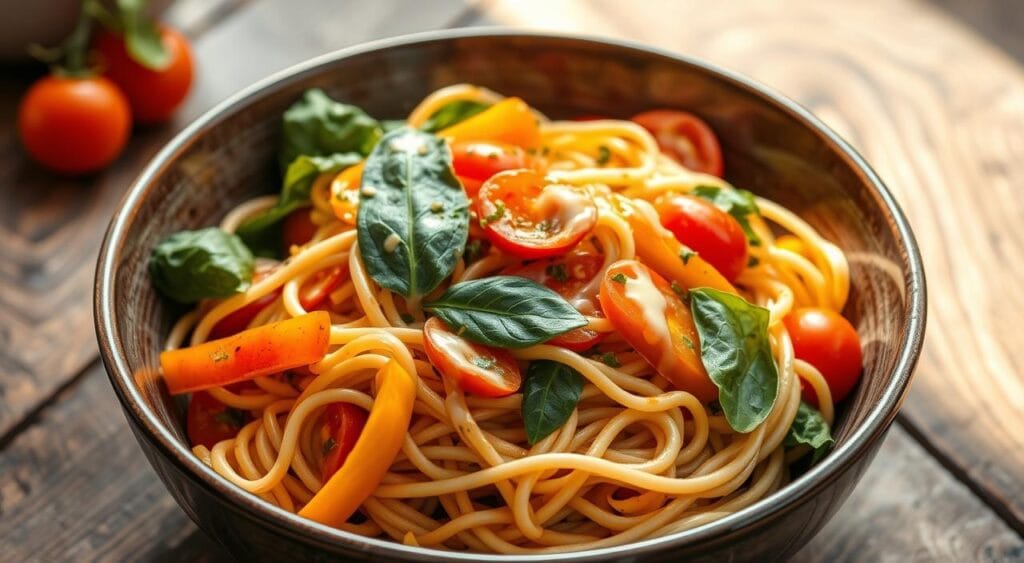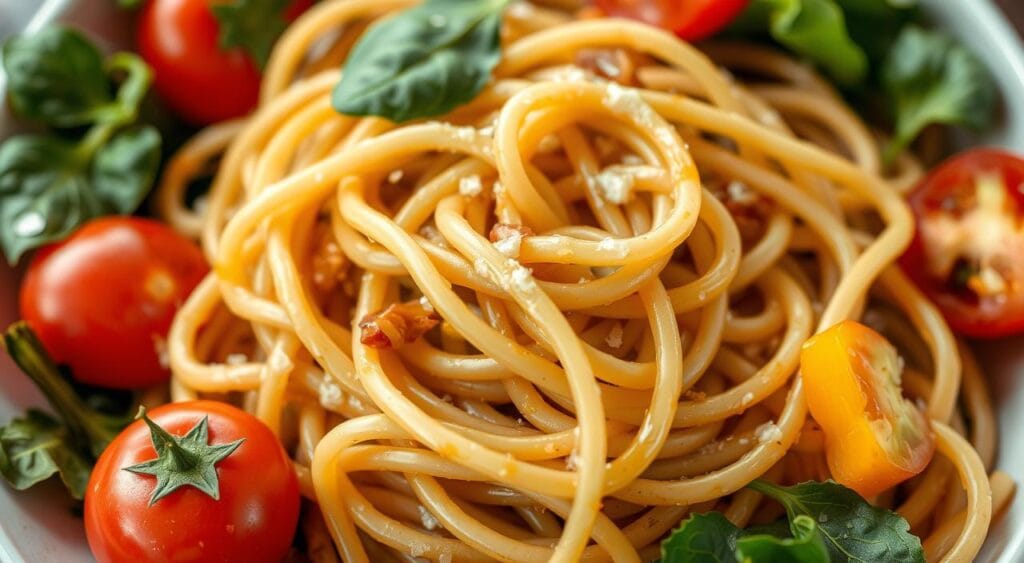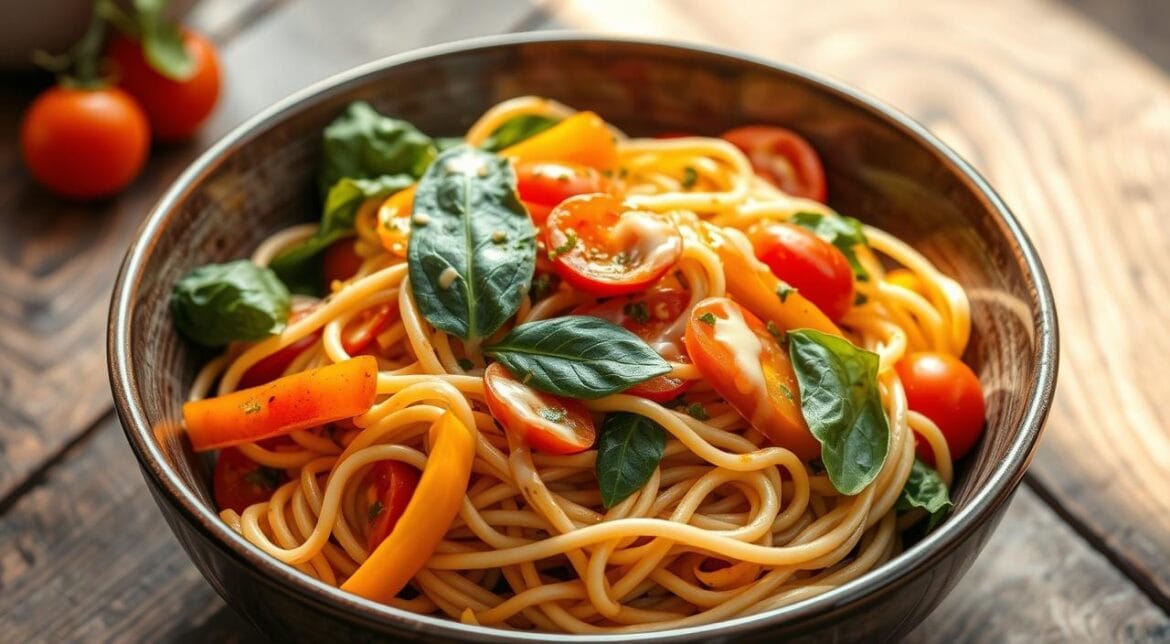Table of Contents
In the world of food and nutrition, a new trend has caught the eye of health-focused people in the U.S. Protein noodles are a game-changer, offering a healthier take on pasta. They meet the need for better food choices. This guide will explore protein noodles, their differences, types, and health perks.

Key Takeaways
- Protein noodles are a nutritious swap for regular pasta, with more protein.
- Find out about the wide variety of protein sources in these noodles, from plants to grains.
- Learn how protein noodles can help with weight, muscle recovery, and more.
- Discover the best protein pasta brands in the U.S. market.
- Get tips on cooking protein noodles right, for the best taste and texture.
Understanding Protein Noodles: What Sets Them Apart
Protein-rich diets are getting more popular. This has led to a demand for pasta that’s not just carbs. Protein noodles are changing how we see pasta. They offer something different from regular wheat-based pasta.
Key Differences Between Regular and Protein-Enhanced Pasta
Protein noodles use different ingredients than regular pasta. Regular pasta is mostly wheat flour. But protein noodles use protein sources like chickpea, lentil, or pea flour. This makes them much more nutritious.
Common Types of Protein Used in Alternative Pasta
- Chickpea flour
- Lentil flour
- Pea protein
- Egg whites
- Whey protein
Nutritional Profile Breakdown
Protein noodles have a lot more protein than regular pasta. A regular pasta serving has 2-4 grams of protein. But protein noodles can have up to 20 grams per serving. They also have fewer carbs and a lower glycemic index, which is good for diabetes.
| Nutrient | Regular Pasta (100g) | Protein Pasta (100g) |
|---|---|---|
| Calories | 370 | 320 |
| Carbohydrates | 72g | 40g |
| Protein | 14g | 24g |
| Fiber | 3g | 8g |
Knowing the differences between regular and protein noodles helps you choose better. They’re great for boosting protein, managing blood sugar, or just enjoying a healthier pasta. Protein noodles offer a fantastic alternative to regular pasta.

Health Benefits of Incorporating Protein Noodles into Your Diet
Looking to upgrade your pasta game and live healthier? Adding high protein pastas to your meals is a great choice. These noodles are packed with protein, offering many health benefits. They can help your body and support your fitness goals.
Muscle Growth and Maintenance
Protein noodles are great for building and keeping muscle. They have more protein than regular pasta. This helps your muscles stay strong and toned.
Weight Management
Choosing protein pasta can also help with weight control. The extra protein makes you feel full longer. This is good for those trying to lose weight or stay fit.
Improved Nutrient Absorption
Protein noodles are not just high in protein. They also have fiber, vitamins, and minerals. These nutrients are good for your health and easier for your body to absorb.
“Adding protein-rich pastas to your diet can transform your meals, offering a nutritious and satisfying way to enjoy your beloved pasta dishes.”
Are you an athlete, fitness lover, or just want to be healthier? Is protein pasta healthy? Absolutely. Switching to high protein pastas lets you enjoy pasta while supporting your body’s health and performance.

Best Protein Pasta Brands and Options on the Market
Looking to add more protein to your diet? Protein-rich pastas are a great choice. They offer a tasty texture and are packed with nutrients. Let’s check out some top protein pasta brands and options in the US.
Plant-Based Protein Pasta Varieties
For those who prefer plant-based proteins, there are many good options. Banza is made from chickpeas and is gluten-free and vegan. Explore Cuisine has a range of plant-based pastas, like lentil, edamame, and green pea varieties.
Grain-Free Protein Pasta Alternatives
Grain-free or low-carb diets have their own options. Miracle Noodle and Palmini use konjac root and hearts of palm. They offer a tasty texture and a protein boost.
Budget-Friendly Options
Protein-rich pastas don’t have to be expensive. Barilla and Gia Russa offer affordable best protein pasta options. These choices let you enjoy more protein without spending a lot.
Whether you want plant-based, grain-free, or budget-friendly options, there’s a wide range of high protein pastas. They’re flavorful, nutritious, and meet different dietary needs and preferences.
How to Cook Protein Noodles Perfectly Every Time
Adding protein-rich noodles to your meals is a great way to increase your protein intake. But, it’s important to cook them right to get the best taste and texture. Whether you’re using plant-based, grain-free, or traditional protein pasta, here are some easy steps to make sure your noodles are always delicious.
The Cooking Process
- Begin by boiling a large pot of water. Use at least 4-6 cups of water for every 8 ounces of dry noodles.
- When the water boils, add the noodles and stir gently to stop them from sticking.
- Cook the noodles as the package says, usually 7-12 minutes. Check if they’re done a bit early.
- Drain the noodles well in a colander. Then, put them back in the pot. Mix with a bit of olive oil or your favorite sauce to stop sticking.
Tips for Optimal Texture
- Don’t overcook: Protein noodles get mushy if cooked too long. Watch the time and check for a firm texture.
- Avoid high heat: Protein pasta is delicate. Cook it on medium heat to avoid burning or sticking.
- Add a splash of oil: Mixing cooked noodles with a teaspoon of olive oil or butter helps keep them from clumping.
By following these easy tips, you can add protein to pasta and enjoy perfectly cooked noodles every time. Try different sauces, seasonings, and toppings to make tasty and healthy pasta dishes.
Comparing Protein Content: Regular Pasta vs. Protein-Enhanced Versions
Pasta can have different amounts of protein, depending on if it’s regular or protein-enhanced. Knowing these differences helps those who want to eat more protein.
Protein Content Per Serving Size
A regular pasta serving, 2 ounces (56 grams) of dry pasta, has about 7-8 grams of protein. High protein pastas offer 15-20 grams of protein. This depends on the protein type and how it’s mixed.
Complete vs. Incomplete Protein Sources
Not all proteins are the same. Regular pasta, mostly made from wheat flour, is an incomplete protein. It’s missing some amino acids the body can’t make. Does pasta contain protein in the form of legumes, eggs, or dairy? These can give you a complete protein, with all the amino acids you need.
| Pasta Type | Protein Content (per 2 oz serving) | Protein Source |
|---|---|---|
| Regular Wheat Pasta | 7-8 grams | Incomplete Protein |
| Protein-Enhanced Pasta | 15-20 grams | Complete Protein |
Knowing the protein differences between regular and protein-enhanced pastas helps you make better choices. This supports your health and fitness goals.
Creative Recipe Ideas for Your Protein Noodles
Protein noodles are a versatile ingredient that can elevate your meals with an added nutritional boost. They offer endless possibilities beyond the classic spaghetti and meatballs. Explore these creative recipe ideas to add more protein to your pasta dishes. Discover the best protein pasta options that cater to your dietary preferences.
Protein-Packed Pasta Primavera
Toss your protein noodles with fresh seasonal vegetables, grilled chicken or shrimp, and a flavorful lemon-garlic sauce. This creates a light yet satisfying pasta primavera. The combination of tender vegetables, lean protein, and al dente noodles makes for a balanced and nutrient-dense meal.
Creamy Protein Pasta Bake
Transform your protein noodles into a comforting and cheesy casserole. Layer the noodles with a creamy sauce, sautéed mushrooms, spinach, and melted mozzarella. This protein-packed pasta bake is perfect for a family-style dinner.
| Recipe | Protein Source | Serving Size | Protein Content (g) |
|---|---|---|---|
| Protein-Packed Pasta Primavera | Chicken, Shrimp | 1 cup | 25 |
| Creamy Protein Pasta Bake | Protein Noodles | 1 serving | 20 |
Remember, the key to successfully incorporating protein noodles into your meals is to experiment with different recipes, flavors, and cooking techniques. Let your creativity shine and enjoy the nutritional benefits of these versatile and delicious pasta alternatives.
Storage Tips and Shelf Life of Protein Pasta
Keeping your protein pasta fresh is important. Whether you have plant-based or grain-free noodles, simple steps can help. This way, you can enjoy their health benefits for a longer time.
Proper Storage Methods
Store your protein pasta in an airtight container or resealable bag. Keep it at room temperature, away from sunlight and heat. Don’t store it in the fridge, as it can dry out.
Protein pasta stays fresh for 12-24 months, depending on the brand. Always verify the expiration or best-by date on the packaging.
Signs of Spoilage to Watch For
- Discoloration or changes in the pasta’s appearance, such as mold or sliminess.
- Off-putting odors or a sour, unpleasant smell.
- Hardened or stale texture that’s difficult to cook.
If you see these signs, throw away the pasta. Spoiled noodles can cause stomach problems. It’s safer to be cautious.
By following these tips and watching for spoilage, you can enjoy your best protein pasta longer. Proper storage and handling make it a great addition to your diet.
Common Mistakes to Avoid When Preparing Protein Pasta
Protein noodles are a great choice for those looking for more protein in their meals. But, it’s important to cook them right to get the best taste and nutrition. Here are some mistakes to avoid when cooking protein pasta.
One key mistake is overcooking. Protein pasta can become mushy if cooked too long. Always check the package for the right cooking time to keep it al dente.
Another mistake is not seasoning enough. Protein pasta can taste bland. So, season it well with salt, herbs, and spices. Try different seasonings to find the best flavor for your dish.
- Don’t rinse the cooked pasta under water. This can make the sauce not stick to the noodles.
- Be careful not to add too much sauce. Protein pasta absorbs more sauce than regular pasta, so adjust the amount.
- Don’t overcrowd the pot when boiling. This can make the noodles stick together. Use a big pot and don’t put too much pasta in it.
By avoiding these mistakes, you can make your protein pasta dishes taste great. The secret to delicious protein pasta is to pay attention to the details and adjust as needed.
Conclusion
Protein noodles are a tasty and healthy choice instead of regular pasta. They let you enjoy pasta’s taste and feel while getting more protein. This extra protein helps with fitness, muscle recovery, and overall health.
Protein noodles are great for making many different dishes. You can make classic Italian meals or try new recipes. It’s all about finding the right protein pasta for you, whether it’s plant-based, grain-free, or affordable.
To make perfect protein noodles, follow the cooking tips in this guide. These tips will help your protein pasta dishes taste great every time. Start exploring protein noodles and enjoy delicious meals that are also good for you.
FAQ
Does pasta contain protein?
Yes, pasta made from wheat flour has a small amount of protein. It usually has about 5-7 grams per serving. But, regular pasta is not a complete protein source.
How can I boost the protein content in my pasta?
You can add more protein to your pasta by using ingredients like grilled chicken or shrimp. Beans, lentils, and tofu are also great options. You can also try protein-enhanced pasta varieties for more protein.
Are protein pastas healthy?
Yes, protein-enhanced pastas are a healthy choice. They have more protein, fiber, and nutrients than regular pasta. This can help with weight management and muscle growth.
What are the best protein pasta brands?
Top brands in the US include Banza, Barilla Protein+, Explore Cuisine, and ProteinHouse. They offer plant-based, grain-free, and budget-friendly options for different diets.
How can I cook protein noodles perfectly?
To cook protein noodles right, follow the package instructions. Note the cooking times, as they might differ from regular pasta. Handle the noodles gently to avoid them becoming mushy or sticking together.

